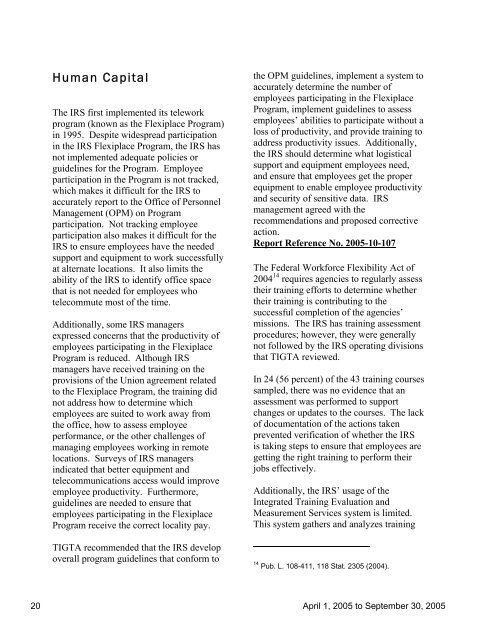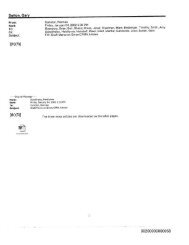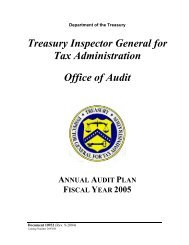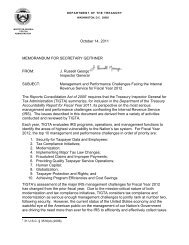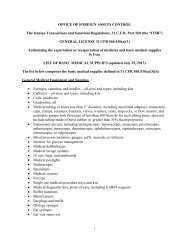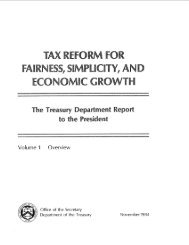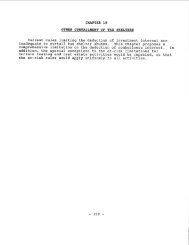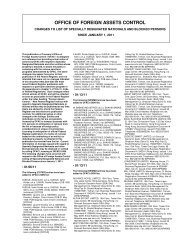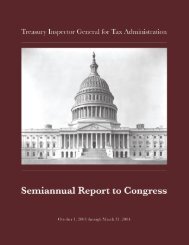PDF - Department of the Treasury
PDF - Department of the Treasury
PDF - Department of the Treasury
You also want an ePaper? Increase the reach of your titles
YUMPU automatically turns print PDFs into web optimized ePapers that Google loves.
Human Capital<br />
The IRS first implemented its telework<br />
program (known as <strong>the</strong> Flexiplace Program)<br />
in 1995. Despite widespread participation<br />
in <strong>the</strong> IRS Flexiplace Program, <strong>the</strong> IRS has<br />
not implemented adequate policies or<br />
guidelines for <strong>the</strong> Program. Employee<br />
participation in <strong>the</strong> Program is not tracked,<br />
which makes it difficult for <strong>the</strong> IRS to<br />
accurately report to <strong>the</strong> Office <strong>of</strong> Personnel<br />
Management (OPM) on Program<br />
participation. Not tracking employee<br />
participation also makes it difficult for <strong>the</strong><br />
IRS to ensure employees have <strong>the</strong> needed<br />
support and equipment to work successfully<br />
at alternate locations. It also limits <strong>the</strong><br />
ability <strong>of</strong> <strong>the</strong> IRS to identify <strong>of</strong>fice space<br />
that is not needed for employees who<br />
telecommute most <strong>of</strong> <strong>the</strong> time.<br />
Additionally, some IRS managers<br />
expressed concerns that <strong>the</strong> productivity <strong>of</strong><br />
employees participating in <strong>the</strong> Flexiplace<br />
Program is reduced. Although IRS<br />
managers have received training on <strong>the</strong><br />
provisions <strong>of</strong> <strong>the</strong> Union agreement related<br />
to <strong>the</strong> Flexiplace Program, <strong>the</strong> training did<br />
not address how to determine which<br />
employees are suited to work away from<br />
<strong>the</strong> <strong>of</strong>fice, how to assess employee<br />
performance, or <strong>the</strong> o<strong>the</strong>r challenges <strong>of</strong><br />
managing employees working in remote<br />
locations. Surveys <strong>of</strong> IRS managers<br />
indicated that better equipment and<br />
telecommunications access would improve<br />
employee productivity. Fur<strong>the</strong>rmore,<br />
guidelines are needed to ensure that<br />
employees participating in <strong>the</strong> Flexiplace<br />
Program receive <strong>the</strong> correct locality pay.<br />
TIGTA recommended that <strong>the</strong> IRS develop<br />
overall program guidelines that conform to<br />
<strong>the</strong> OPM guidelines, implement a system to<br />
accurately determine <strong>the</strong> number <strong>of</strong><br />
employees participating in <strong>the</strong> Flexiplace<br />
Program, implement guidelines to assess<br />
employees’ abilities to participate without a<br />
loss <strong>of</strong> productivity, and provide training to<br />
address productivity issues. Additionally,<br />
<strong>the</strong> IRS should determine what logistical<br />
support and equipment employees need,<br />
and ensure that employees get <strong>the</strong> proper<br />
equipment to enable employee productivity<br />
and security <strong>of</strong> sensitive data. IRS<br />
management agreed with <strong>the</strong><br />
recommendations and proposed corrective<br />
action.<br />
Report Reference No. 2005-10-107<br />
The Federal Workforce Flexibility Act <strong>of</strong><br />
2004 14 requires agencies to regularly assess<br />
<strong>the</strong>ir training efforts to determine whe<strong>the</strong>r<br />
<strong>the</strong>ir training is contributing to <strong>the</strong><br />
successful completion <strong>of</strong> <strong>the</strong> agencies’<br />
missions. The IRS has training assessment<br />
procedures; however, <strong>the</strong>y were generally<br />
not followed by <strong>the</strong> IRS operating divisions<br />
that TIGTA reviewed.<br />
In 24 (56 percent) <strong>of</strong> <strong>the</strong> 43 training courses<br />
sampled, <strong>the</strong>re was no evidence that an<br />
assessment was performed to support<br />
changes or updates to <strong>the</strong> courses. The lack<br />
<strong>of</strong> documentation <strong>of</strong> <strong>the</strong> actions taken<br />
prevented verification <strong>of</strong> whe<strong>the</strong>r <strong>the</strong> IRS<br />
is taking steps to ensure that employees are<br />
getting <strong>the</strong> right training to perform <strong>the</strong>ir<br />
jobs effectively.<br />
Additionally, <strong>the</strong> IRS’ usage <strong>of</strong> <strong>the</strong><br />
Integrated Training Evaluation and<br />
Measurement Services system is limited.<br />
This system ga<strong>the</strong>rs and analyzes training<br />
14 Pub. L. 108-411, 118 Stat. 2305 (2004).<br />
20 April 1, 2005 to September 30, 2005


